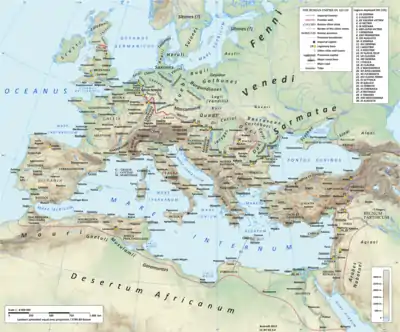Legio III Gallica
Legio III Gallica (Legio Tertia Gallica, "Gallic Third Legion") was a legion of the Imperial Roman army founded around 49 BC by Gaius Julius Caesar for his civil war against the republicans led by Pompey. The cognomen Gallica suggests that recruits were originally from Gaul. The legion was established in Raphanea, Roman Syria, and was still active in Egypt in the early 4th century. The legion's symbol was a bull.

 |
| Part of a series on the |
| Military of ancient Rome |
|---|
|
|
Under the Republic
The legion was founded in either 49 or 48 BCE by Julius Caesar to help in Caesar's war against Pompey.[1] The soldiers of the legion were exclusively from Transalpine Gaul and Cisalpine Gaul. After Caesar died, the III Gallica joined Mark Antony's army.[1] While in the service of Mark Antony the legion would fight at the battle of Munda and Phillipi. They were included in the army levied by Fulvia and Lucius Antonius to oppose Octavian, but ended by surrendering in Perugia, in the winter of 41 BC.[1]
Under the Empire
Service under Herod and service in Antony's campaign against the Parthians
The legion served in Antony's Parthian War in 36 BC. After the battle of Actium and Antony's suicide during Antony's Civil War, the III Gallica was sent again to the East, where they garrisoned the province of Syria.[1]
Campaigning under Corbulo and transferring to the Danube
III Gallica was used in Gnaeus Domitius Corbulo's campaign against the Parthians over the control of Armenia.[1] It was also commanded by Corbulo.[1] The campaign lasted from 58-68 AD. Because of the campaign it was stationed in Armenia. Corbulo's successes triggered the emperor Nero's paranoia of persecution and eventually the general was forced to commit suicide. After this, III Gallica was transferred to the province of Moesia on the Danube.
Year of the Four Emperors
In the Year of the Four Emperors in 69, the legion, and the rest of the Danubian army, aligned first with Otho, then with Vespasian. They were instrumental in the final defeat of Vitellius in the second Battle of Bedriacum and in the accession of the Flavians to the throne of Rome. This legion during its service in Syria had developed the custom of saluting the rising sun, and when dawn broke at Bedriacum they turned east to do so. The Vitellian forces thought that they were saluting reinforcements from the east and lost heart.[1] Following the defeat of Vitellius the legion was moved to Capua.[1]
In Syria

After this civil war, the legion was again sent to Syria.[1] The reason they returned is because other legions were fighting the Jews, and Syria was left unmanned.[1]The legion was probably based at Raphanaea.[1] Raphanaea was captured by a Roman army in 71 AD. The III Gallica may have participated in the expedition.[1]While the legion was in Syria, some subunits may have fought in Trajan and Domitian's Dacian wars.[1]It is also very likely that the legion took part in Trajan's Parthian wars. The III Gallica fought against the Jewish rebellion of the 2nd century. They also took part in Lucius Verus' campaign against the Parthians. During a Roman civil war the Syrian Legions, the III Gallica included, supported Pescennius Niger.[1]Eventually Septimus Severus, another claimant to the title of Roman Emperor would win the war. Septimius Severus would campaign against the Parthian Empire, none with noteworthy(?) success(Ctesiphon captured). One of the legions that fought in this campaign was the III Gallica.[1] During the reign of Roman Emperor Caracalla, the Legion left an inscription amongst the Commemorative stelae of Nahr el-Kalb.[1] III Gallica played a central role in the early reign of Elagabalus. In 218, during Macrinus' reign, Julia Maesa went to Raphana, Syria, where the legion was based under the command of Publius Valerius Comazon. She largely donated to the legion, which, in turn, proclaimed emperor Julia Maesa's grandson, the fourteen-year-old Elagabalus, on the dawn of 16 May. On June 8, 218 near Antioch. Gannys, Elagabalus' tutor, defeated Macrinus and his son, with the help of the III Gallica and the other legions of the East. In 219, the legion, exhausted by Elagabalus excesses, supported its commander, senator Verus, who proclaimed himself emperor. Elagabalus had Verus executed, and dispersed the legion. The legionaries were transferred namely to III Augusta, stationed in the Africa provinces. However, the following emperor, Alexander Severus, reconstituted the legion and redeployed them back in Syria. Valerius Comazon entered in Elagabalus court, becoming prefect of the Praetorian Guard and consul in 220. III Gallica records then become obscure. The legion partook in Alexander's campaign against the Sassanids.[1]
Attested members
| Name | Rank | Time frame | Province | Source |
|---|---|---|---|---|
| Lucius Artorius Castus | centurio | between 150 and 250 | Syria | CIL III, 1919 |
| Titus Aurelius Fulvus | legatus legionis | 65-69 | Moesia | CIL III, 6741 = ILS 232; Tacitus, Histories, I.79 |
| Gaius Dillius Aponianus | legatus legionis | 69-70 | Moesia | Tacitus, Histories, III.10,11 |
| Lucius Aurelius Gallus | legatus legionis | 121-123 | Syria | CIL VI, 1356 = ILS 1109 |
| Gaius Javolenus Calvinus[2] | legatus legionis | c. 138 | Syria | CIL XIV, 2499 |
| Marcus Servilius Fabianus Maximus[2] | legatus legionis | c. 150–c. 153 | Syria | CIL VI, 1517 |
| Avidius Cassius[2] | legatus legionis | c. 162–c.166 | Syria | |
| Arrius Varus | primipilus | 69 | Moesia | Tacitus, Histories, III.16, IV.19 |
| Sextus Appius Sex. f. Severus | tribunus laticlavius | between 68 and 76 | Syria | CIL VI, 1348 = ILS 1003 |
| Gaius Plinius Caecilius Secundus | tribunus laticlavius | 80s | Syria | CIL V, 5262 |
| Gaius Bruttius Praesens | tribunus laticlavius | c. 136 | Syria | CIL X, 408 = ILS 1117 |
| Marcus Messius Rusticianus[3] | tribunus laticlavius | c. 135-140 | Syria | |
| Lucius Pullaienus Gargilius Antiquus | tribunus laticlavius | c. 145 | Syria | CIL III, 7394 |
See also
References
- "Legio III Gallica - Livius". www.livius.org. Retrieved 2020-08-02.
- Géza Alföldy, Konsulat und Senatorenstand unter der Antoninen (Bonn: Rudolf Habelt Verlag, 1977), p. 298
- Bernard Rémy, Les carrières sénatoriales dans les provinces romaines d'Anatolie au Haut-Empire (31 av. J.-C. - 284 ap. J.-C.) (Istanbul: Institut Français d'Études Anatoliennes-Georges Dumézil, 1989), p. 266
